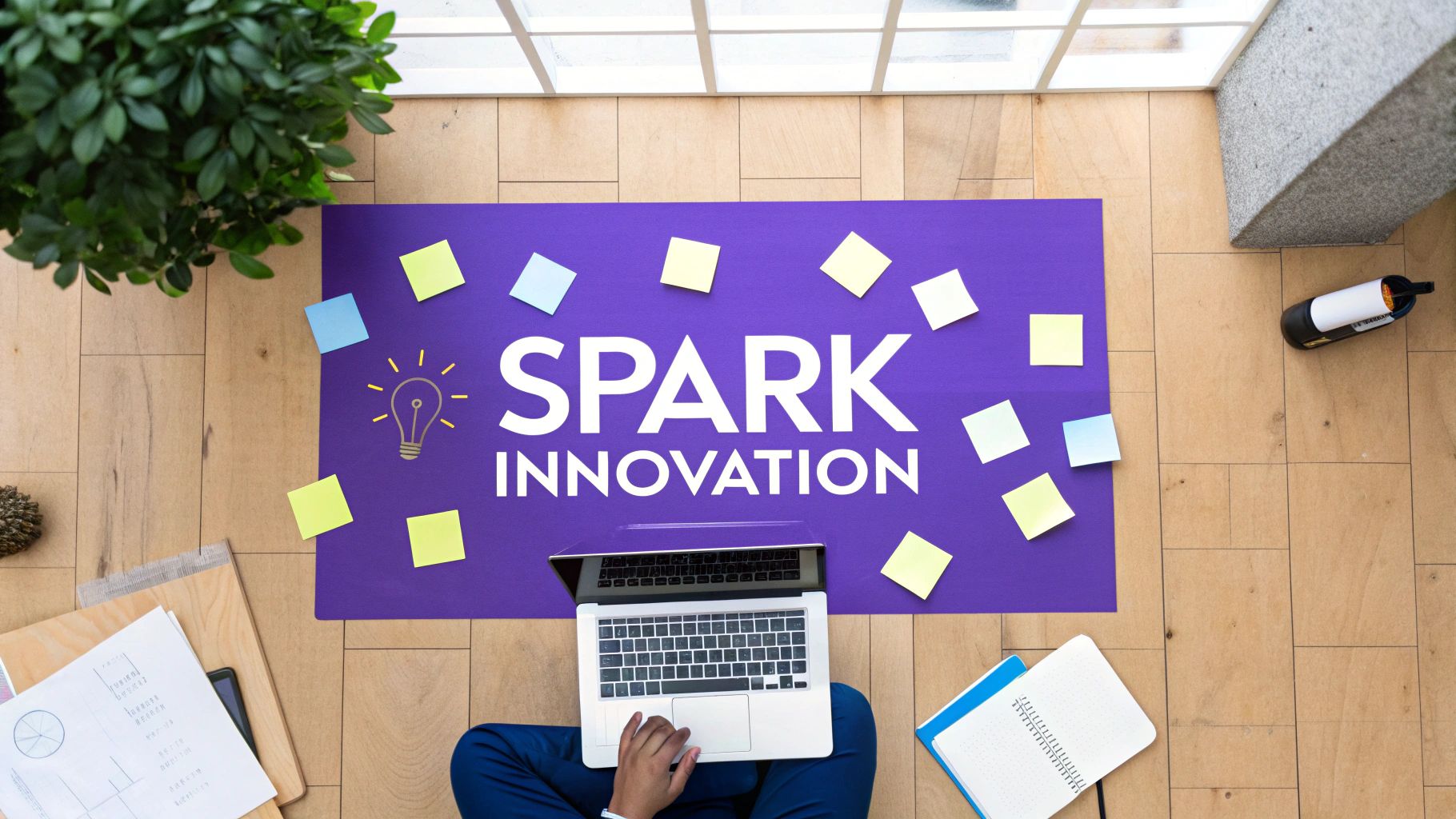In today's fast-paced world, innovation isn't a luxury; it's the engine of survival and growth. Yet, brainstorming sessions often fall flat, recycling the same tired ideas. This is especially true for remote teams, where digital fatigue can stifle the free-flowing creativity needed for a real breakthrough. To truly spark your next breakthrough, it's essential to understand how to effectively unlock the power of brainstorming. The problem isn't a lack of talent; it's a lack of the right catalysts. The questions we ask dictate the answers we get. Generic queries lead to generic solutions. To unlock truly disruptive ideas, you need a new toolkit.
This article provides a curated list of powerful, research-backed innovation brainstorming questions designed to shatter conventional thinking. We will move beyond the obvious and explore seven specific, actionable prompts that challenge assumptions, reframe problems, and open new pathways for your team. Each question is a key to a different room of creative thought, complete with a guide on how to use it, examples of its power, and tips for implementing it in your next remote session. Prepare to transform your team's approach from incremental tweaks to game-changing leaps.
1. What Would Happen If We Removed This Feature/Process Entirely?
This powerful subtraction-based question forces teams to confront a natural bias: the tendency to add more rather than take away. By challenging the very existence of a feature, process, or component, you can cut through legacy thinking and uncover hidden complexities. This method isn't about incremental tweaks; it’s about radical simplification. It asks your team to justify an element’s existence from a zero base, often revealing that its original purpose is no longer relevant or could be achieved in a much simpler way.

This approach, popularized by design thinking practitioners and lean startup advocates, helps identify bloated products and inefficient workflows. It’s one of the most effective innovation brainstorming questions because it shifts the focus from "What can we add?" to "What is truly essential?". The constraint of removal forces a level of creativity that simple addition does not.
How It Sparks Innovation
Consider Tesla's move to eliminate the traditional car dealership model. By removing the middleman, they completely reimagined the car-buying experience, creating a direct-to-consumer relationship that gives them full control over pricing, service, and brand messaging. Similarly, Stripe revolutionized online payments by removing the historically complex and lengthy setup processes, offering a solution developers could implement in minutes, not weeks.
Key Insight: Removing a core component forces you to solve the underlying customer problem in a fundamentally new way. This constraint is a direct path to disruptive innovation.
How to Implement This Question Remotely
This exercise is perfect for a virtual whiteboard session.
- Step 1: Identify Targets: Create a list of features or process steps on a shared digital canvas. Start with components that are less critical to build confidence and momentum.
- Step 2: Document Assumptions: Before discussing removal, have each team member silently write down all the assumptions about why a feature exists and what would break if it were gone. This prevents groupthink.
- Step 3: "What If" Scenario: Pick a feature and ask the core question. Use a timer (e.g., 10 minutes) for the team to brainstorm all the consequences, both positive and negative, of its removal.
- Step 4: Explore Alternatives: Discuss the gaps created by the removal. Brainstorm new, simpler ways to address the customer need the feature was originally built to solve.
This structured approach ensures that you analyze the potential impacts thoroughly, considering everything from immediate user confusion to long-term strategic advantages. By systematically challenging every piece of your product or process, you can build something leaner, more focused, and ultimately more innovative.
2. How Would a Child Approach This Problem?
This perspective-shifting question is designed to dismantle the complex frameworks of adult thinking. It asks teams to shed their learned constraints, industry jargon, and fear of failure, and instead adopt the boundless curiosity and simplicity of a child's mind. Children don't see impossibilities; they see building blocks and ask "Why?" relentlessly. This approach bypasses years of ingrained assumptions, leading to solutions that are often surprisingly direct and user-friendly.

Popularized by design thinking pioneers like IDEO and lateral thinking experts such as Edward de Bono, this technique is one of the most powerful innovation brainstorming questions for breaking through creative blocks. It encourages a return to first principles by focusing on play, experimentation, and pure function, unburdened by the "right way" of doing things. It's about finding the fun in problem-solving.
How It Sparks Innovation
Consider how LEGO's entire modular system is built on the logic of children's play. The simple, intuitive "click" of the bricks allows for infinite creativity without a complex manual. Similarly, the invention of Velcro was inspired by a child-like observation of how burrs stuck to a dog's fur, a simple natural mechanism that an adult might have dismissed as a mere annoyance. Voice assistants like Alexa succeed by responding to natural, conversational language, much like how a child would ask for something, rather than requiring rigid, technical commands.
Key Insight: Adopting a child's mindset strips away expert bias and over-analysis, forcing you to find the simplest and most intuitive path to a solution.
How to Implement This Question Remotely
This question is ideal for making remote sessions more engaging and playful. You can explore more ideas with these creative thinking exercises for groups.
- Step 1: Set the Stage: Announce that for the next part of the session, all "adult" constraints like budget, feasibility, and past failures are temporarily banned. The goal is pure, unfiltered ideation.
- Step 2: Use Playful Prompts: On a virtual whiteboard, ask team members to answer the question: "If you were 8 years old, how would you solve this?" Encourage them to use digital drawing tools, emojis, and simple language instead of formal text.
- Step 3: The "Five Whys": Choose a core aspect of the problem and have the team repeatedly ask "Why?" like a curious child. This helps drill down to the fundamental user need, moving past surface-level assumptions.
- Step 4: Capture Everything: Document every idea, no matter how silly or impractical it seems. The goal is to generate a high volume of raw concepts that can be refined later.
This playful and judgment-free approach encourages psychological safety, allowing quieter team members to contribute more freely and unlocking unconventional solutions that a more formal process would stifle.
3. What If We Had Unlimited Resources?
This expansive question liberates teams from the gravitational pull of everyday constraints. By asking what you would build with an infinite budget, unlimited time, and access to any technology or talent, you temporarily suspend the practical limitations that often stifle ambitious thinking. This exercise isn't about fantasy; it's a strategic tool to define the ultimate vision for your product or service without being anchored by perceived feasibility.

Popularized within Silicon Valley culture and by innovation consultancies like IDEO, this question encourages "blue sky" thinking. It is one of the most effective innovation brainstorming questions because it shifts the mindset from "What can we do?" to "What should we do?". Once the ideal state is defined, the team can then work backward to find surprisingly creative ways to approximate that vision with the resources they actually have. This method can help you find more ways to generate business ideas.
How It Sparks Innovation
Consider SpaceX's mission to colonize Mars. This seemingly impossible goal, conceived with an "unlimited resources" mindset, drove the non-negotiable need for reusable rockets, a disruptive innovation that has fundamentally changed the economics of space travel. Similarly, Google’s legendary "20% time," where engineers could work on projects outside their core responsibilities, was a form of institutionalized unlimited-resource thinking that led to breakthroughs like Gmail and AdSense.
Key Insight: Removing constraints reveals the true, uncompromised value you want to deliver. This "north star" vision becomes a powerful motivator and a guide for prioritizing real-world efforts.
How to Implement This Question Remotely
This aspirational exercise is highly effective in a collaborative digital environment.
- Step 1: Set the Stage: Clearly state that for the next 15-20 minutes, all constraints are gone. No budget limits, no tech hurdles, no resource shortages. The goal is to envision the perfect solution.
- Step 2: Dream Big on the Whiteboard: On a shared virtual whiteboard, pose the question: "If we had unlimited resources, what would we build to solve our customer's core problem?" Have everyone add their ideas on digital sticky notes. Encourage wild, ambitious concepts.
- Step 3: Identify Core Principles: Group the ideas into themes. Discuss the underlying principles behind the "perfect" solutions. What fundamental user needs are being met? What makes these ideas so desirable?
- Step 4: Reintroduce Constraints: After the ideation phase, ask: "How can we achieve 10% of this vision with 1% of the resources?" This final step bridges the gap between the ideal and the practical, often sparking clever, low-cost experiments that move you toward the grand vision.
4. How Would Our Biggest Competitor Solve This?
This competitive role-playing question forces teams to step outside their own organizational echo chamber and view a problem through a rival's lens. By analyzing a competitor's strategies, resources, and mindset, you can reverse-engineer their potential solutions. This isn't about copying; it's about deconstructing their approach to uncover blind spots in your own thinking and identify opportunities they might exploit. It challenges you to consider different business models, technologies, and market entry points.

This method, a cornerstone of competitive intelligence and strategic management, is one of the most practical innovation brainstorming questions because it grounds creativity in market reality. It moves the conversation from abstract "what ifs" to concrete "how would theys," encouraging a pragmatic and strategic approach to problem-solving. It's a powerful reminder that innovation is a process of continuous learning and adaptation, not just a single flash of brilliance.
How It Sparks Innovation
Consider how Netflix studied HBO's model of producing high-quality, award-winning original content. By analyzing HBO's success, Netflix shifted its strategy from being a content distributor to a content creator, leading to hits like "House of Cards" and "Stranger Things." Similarly, Amazon constantly examines Walmart's logistical prowess, adopting and innovating on warehouse automation and last-mile delivery to build its e-commerce dominance.
Key Insight: Adopting a competitor's perspective reveals your own operational biases and uncovers strategic paths you would otherwise ignore.
How to Implement This Question Remotely
This exercise is highly effective in a collaborative virtual setting.
- Step 1: Assign Roles: Assign different competitors to small breakout groups. If you only have one major competitor, assign different departments of that company (e.g., their marketing team, their engineering team).
- Step 2: Create Competitor Profiles: On a shared document or virtual whiteboard, have each group build a profile for their assigned competitor. Include their known strengths, weaknesses, core technologies, and recent market moves.
- Step 3: Role-Play Brainstorm: Pose your current challenge to the groups. Give them 15-20 minutes to brainstorm solutions as if they were the competitor. They must use the competitor's assets and mindset, not their own.
- Step 4: Share and Analyze: Bring everyone back to the main session. Each group presents their competitor's "solution." Discuss the insights and identify the most threatening or innovative ideas that emerged.
This structured role-play helps your team anticipate competitive moves and discover new avenues for differentiation, turning competitive analysis into a proactive tool for innovation.
5. What If We Combined Two Unrelated Industries/Concepts?
This powerful combinatorial question pushes teams beyond their immediate competitive landscape to find inspiration in unexpected places. The core idea is that solutions perfected in one industry can be revolutionary when applied to another. By intentionally connecting seemingly unrelated concepts, you can spark breakthrough ideas that defy conventional market categories and create entirely new value propositions.
This method forces a cross-pollination of ideas, moving beyond incremental improvements to create something fundamentally new. It's one of the most effective innovation brainstorming questions because it leverages existing, proven models and reapplies them in novel contexts, often with surprising success. The challenge isn't inventing from scratch; it's the creative act of translation and integration.
How It Sparks Innovation
Consider Airbnb, which combined the hospitality industry with the peer-to-peer sharing economy model popularized by tech platforms. This fusion created a new category of travel accommodation. Similarly, Peloton brilliantly merged fitness equipment (the stationary bike) with social media engagement and on-demand content streaming, transforming a solitary home workout into a connected, competitive experience. Square did the same by mixing traditional payment processing with the simplicity and accessibility of mobile app technology.
Key Insight: True breakthroughs often happen at the intersection of different fields. Combining established concepts from separate domains can unlock new markets and solve old problems in completely new ways.
How to Implement This Question Remotely
This exercise thrives in a creative, open-minded virtual setting.
- Step 1: Identify Your Core Industry: On a virtual whiteboard, clearly define your industry and the core customer problem you solve. For example, "local food delivery" or "project management software."
- Step 2: Brainstorm Unrelated Industries: As a team, create a list of completely unrelated industries or concepts. Think broadly: video gaming, professional sports, subscription boxes, K-pop fan culture, aerospace engineering, or even biomimicry.
- Step 3: Force Connections: Randomly pair your industry with one from the unrelated list. Set a timer (e.g., 15 minutes) and ask the team to brainstorm: "How could we apply principles from [Unrelated Industry] to solve problems in [Our Industry]?"
- Step 4: Extract and Refine Principles: Instead of just copying features, focus on the underlying principles. What makes the subscription box model successful? It’s convenience, curation, and surprise. How could those principles apply to your product?
This structured approach is a core part of many idea generation techniques. It systematically guides your team to look far beyond the usual sources of inspiration, paving the way for truly disruptive ideas.
6. What Would This Look Like If We Made It 10x Better/Faster/Cheaper?
This exponential improvement question, popularized by Google's "moonshot" innovation lab, forces teams to abandon incremental thinking. Instead of optimizing what already exists, you must envision a solution that is an order of magnitude superior. This "10x thinking" makes it nearly impossible to stick with current methods and requires a fundamental reimagining of the problem and its potential solutions.
This approach is designed to produce breakthroughs, not just improvements. It challenges your team to ask what foundational assumptions would need to change to achieve such a dramatic leap in performance, cost, or speed. It’s one of the most demanding innovation brainstorming questions because it shifts the goal from "making things better" to "making things fundamentally different."
How It Sparks Innovation
Consider SpaceX's goal to make space access 10x cheaper. This couldn't be achieved by making traditional rockets slightly more efficient; it required a completely new approach: reusable rockets. Similarly, Amazon Prime didn't just offer slightly faster shipping. It created a service that made delivery feel almost instantaneous compared to the standard, forcing a reinvention of logistics, warehousing, and customer expectations.
Key Insight: Aiming for a 10x improvement forces you to identify and overcome the core constraints of an existing system, leading to true disruption rather than simple optimization.
How to Implement This Question Remotely
This high-concept question works well in a focused virtual workshop where you can explore radical ideas without immediate judgment.
- Step 1: Define the "1x": On a digital whiteboard, clearly define the current state. What is the current cost, speed, or performance metric you are trying to improve? Be specific (e.g., "Our customer onboarding takes 45 minutes").
- Step 2: Set the 10x Goal: State the audacious goal clearly (e.g., "How could we make onboarding take 4.5 minutes?"). This frames the brainstorming session.
- Step 3: Identify Blockers: Have the team silently list all the reasons why the 10x goal seems impossible with your current process or technology. These "blockers" are your innovation targets.
- Step 4: Brainstorm Enabling Breakthroughs: For each blocker, brainstorm what new technology, process, or assumption change would be needed to make it disappear. Encourage wild ideas, as the goal is to break free from existing constraints.
This structured approach channels the seemingly impossible 10x goal into a practical search for the specific breakthroughs required to get there. It transforms a daunting challenge into a focused map for innovation.
7. What If the Opposite Were True?
This contrarian thinking question forces a direct challenge to the foundational assumptions your entire business or product is built upon. Instead of iterating on what exists, you deliberately explore a completely reversed reality. This mental exercise is designed to break ingrained industry norms and reveal powerful, non-obvious opportunities that conventional wisdom completely misses. It’s one of the most potent innovation brainstorming questions for achieving true differentiation.
By inverting your core beliefs, you move beyond incremental improvements and into the realm of radical re-imagination. This approach asks your team to analyze why the status quo exists and whether a polar opposite model could serve an overlooked market segment or solve a problem in a fundamentally better way. It’s a direct path to creating a new category or redefining an existing one.
How It Sparks Innovation
Consider Southwest Airlines, which asked, "What if flying was informal and cheap, not formal and expensive?" By reversing the industry norm of premium, hub-and-spoke service, they created the low-cost carrier model. Similarly, Patagonia challenged the consumerist mindset by telling customers not to buy their jackets, instead promoting repair and reuse. This opposite approach built immense brand loyalty and highlighted their commitment to sustainability, creating a unique competitive advantage.
Key Insight: Challenging your most fundamental assumptions and exploring their opposites can unlock disruptive business models that your competitors are structurally unable to copy.
How to Implement This Question Remotely
This contrarian exercise thrives in a structured virtual workshop environment.
- Step 1: Identify Core Assumptions: On a shared digital whiteboard, collaboratively list the "undeniable truths" about your industry, product, or customer. Examples might include "customers want more features" or "our service must be delivered in person."
- Step 2: Invert the Assumptions: Create a second column and write the direct opposite of each assumption. For "customers want more features," the opposite is "customers want fewer features" or "customers want only one feature."
- Step 3: Brainstorm the "Opposite World": Choose one inverted assumption and dedicate 15 minutes to brainstorming what a product or company built on this new "truth" would look like. What would you offer? Who would you sell to? What would be your competitive advantage?
- Step 4: Analyze for Viability: Discuss the ideas generated. Are there niche markets that would love this opposite approach? Could this inverted model be more profitable or sustainable? This process often reveals fresh, actionable strategies.
This method pushes your team to think like true innovators by deconstructing the rules everyone else follows. Exploring these inverted realities with a series of open-ended questions can uncover groundbreaking ideas. You can learn more about how to ask effective open-ended questions at remotesparks.com to get the most out of this exercise.
7 Innovation Brainstorming Questions Compared
| Brainstorming Question | Implementation Complexity 🔄 | Resource Requirements ⚡ | Expected Outcomes 📊 | Ideal Use Cases 💡 | Key Advantages ⭐ |
|---|---|---|---|---|---|
| What Would Happen If We Removed This Feature/Process Entirely? | Medium – requires careful analysis | Moderate – stakeholder involvement | Simplification, innovation, core value focus | When accumulated complexity needs reduction | Reveals hidden dependencies, promotes minimalist solutions |
| How Would a Child Approach This Problem? | Low – needs open, playful mindset | Low – use of props, free ideation | Simple, creative, intuitive solutions | Teams stuck in conventional thinking or needing creative breakthroughs | Breaks biases, fosters fearless creativity |
| What If We Had Unlimited Resources? | Medium – visionary but must ground ideas later | High – unconstrained ideation session | Breakthrough innovations, ideal outcomes | When current constraints limit vision | Encourages ambitious thinking, reveals priority outcomes |
| How Would Our Biggest Competitor Solve This? | Medium – requires market research | Moderate – competitor analysis | Realistic, proven strategies | When external perspective or benchmarking is needed | Offers validated approaches, identifies market gaps |
| What If We Combined Two Unrelated Industries/Concepts? | Medium to High – requires broad knowledge | Moderate – research and prototyping | Breakthrough, hybrid innovations | Seeking disruptive innovation or bored of traditional methods | Stimulates analogical thinking, reveals unexpected synergies |
| What Would This Look Like If We Made It 10x Better/Faster/Cheaper? | High – demands radical redesign | High – resource intensive | Disruptive breakthroughs, scalability | When incremental improvements are insufficient | Drives exponential innovation and competitive advantage |
| What If the Opposite Were True? | Medium – challenges core assumptions | Low to Moderate – ideation and testing | Differentiated, contrarian solutions | When seeking differentiation or stuck in status quo | Uncovers hidden assumptions, fosters unique positioning |
From Questions to Actionable Innovation
The right question at the right time is the most powerful tool for innovation. The seven prompts we've explored are designed to be more than just conversation starters; they are strategic lenses that help your team see old problems in entirely new ways. These are the tools that break the cycle of predictable thinking and push you toward genuine breakthroughs.
Whether you're removing features to find core value, thinking like a child to unlock pure creativity, or aiming for 10x improvement to redefine your market, each question provides a structured path to escape incrementalism. By consistently applying these frameworks, you shift your team’s mindset from “Can we do this?” to “How can we do this?” This subtle change is the engine of disruptive innovation.
Turning Inquiry into Impact
Mastering these innovation brainstorming questions is not about memorizing a list. It's about building a new mental muscle. The true value emerges when these prompts become a natural part of your team's problem-solving vocabulary, used instinctively to challenge assumptions and reframe challenges.
Here are your actionable next steps to embed this practice:
- Start Small and Be Deliberate: Don't try to use all seven questions in a single meeting. For your next brainstorming session, choose just one question that best aligns with your specific challenge. If you're stuck in a feature-heavy roadmap, try the "remove" question. If you're entering a crowded market, ask how a competitor would solve the problem.
- Create Psychological Safety: These questions require vulnerability. To get the most audacious and creative ideas, you must cultivate an environment where no suggestion is "stupid." Emphasize that the goal is to explore possibilities, not to find the perfect answer immediately. This is especially critical in remote or hybrid settings where it can be harder to read the room.
- Validate Your Breakthroughs: Brilliant ideas born from these questions are still just hypotheses. Once your team generates a promising new concept, the next crucial step is to ground it in reality. The best way to do this is by learning how to get customer feedback effectively to ensure your innovation solves a real, pressing user need before you invest significant resources.
True, sustainable innovation is a repeatable process, not a random stroke of luck. It is built on a foundation of disciplined curiosity. By arming your team with a powerful arsenal of innovation brainstorming questions, you are not just hoping for a great idea; you are building a system that generates them consistently. You are empowering every individual to become an engine for growth and discovery, turning every challenge into an opportunity for a breakthrough.
Ready to transform your brainstorming sessions from chaotic calls into structured, innovation-driven workshops? Bulby integrates guided, research-backed questions directly into your remote workflow, ensuring every voice is heard and every great idea is captured. Try Bulby today to see how the right questions can unlock your team's full creative potential.

